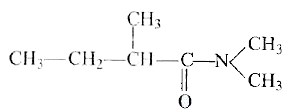A(C4H6)H2,Li−−−→1moleB(C4H8)1.O3−−−−−→2H2O/ZnCH3CHO Thus A and B are :


CH3CH2C≡CH,CH3CH=CHCH3
CH2=CH−CH=CH2,CH3CH=CHCH3
To solve the problem, we need to identify the compounds A (C₄H₆) and B (C₄H₈) based on the given reactions.
1. Identify Compound A (C₄H₆):
- The molecular formula C₄H₆ indicates that compound A is likely an alkyne because it has a higher hydrogen deficiency (two fewer hydrogens than the corresponding alkane C₄H₁₀).
- A common alkyne with this formula is 1-butyne (CH₃C≡CCH₃) or 2-butyne (CH₃C≡CCH₃).
2. Reaction of A with H₂ and Li:
- The reaction of an alkyne with hydrogen (H₂) in the presence of a lithium catalyst (Li) results in the formation of an alkene.
- For example, 1-butyne (C₄H₆) can be converted to 1-butene (C₄H₈) or 2-butene (C₄H₈) through this hydrogenation process.
3. Identify Compound B (C₄H₈):
- After the hydrogenation, we have compound B, which is an alkene (C₄H₈).
- The possible structures for B include 1-butene (CH₂=CH-CH₂-CH₃) or 2-butene (CH₃-CH=CH-CH₃).
4. Ozonolysis of B:
- The ozonolysis reaction involves treating the alkene (B) with ozone (O₃) followed by hydrolysis (H₂O/Zn).
- This reaction cleaves the double bond and forms carbonyl compounds. For 1-butene or 2-butene, ozonolysis would yield two moles of acetaldehyde (CH₃CHO).
5. Final Identification:
- Therefore, compound A is an alkyne (1-butyne or 2-butyne), and compound B is an alkene (1-butene or 2-butene).
- The final products after ozonolysis are two moles of acetaldehyde (CH₃CHO).
Conclusion:
- Compound A (C₄H₆): 1-butyne (or 2-butyne)
- Compound B (C₄H₈): 1-butene (or 2-butene)
- The molecular formula C₄H₆ indicates that compound A is likely an alkyne because it has a higher hydrogen deficiency (two fewer hydrogens than the corresponding alkane C₄H₁₀).
- A common alkyne with this formula is 1-butyne (CH₃C≡CCH₃) or 2-butyne (CH₃C≡CCH₃).
- The reaction of an alkyne with hydrogen (H₂) in the presence of a lithium catalyst (Li) results in the formation of an alkene.
- For example, 1-butyne (C₄H₆) can be converted to 1-butene (C₄H₈) or 2-butene (C₄H₈) through this hydrogenation process.
- After the hydrogenation, we have compound B, which is an alkene (C₄H₈).
- The possible structures for B include 1-butene (CH₂=CH-CH₂-CH₃) or 2-butene (CH₃-CH=CH-CH₃).
- The ozonolysis reaction involves treating the alkene (B) with ozone (O₃) followed by hydrolysis (H₂O/Zn).
- This reaction cleaves the double bond and forms carbonyl compounds. For 1-butene or 2-butene, ozonolysis would yield two moles of acetaldehyde (CH₃CHO).
- Therefore, compound A is an alkyne (1-butyne or 2-butyne), and compound B is an alkene (1-butene or 2-butene).
- The final products after ozonolysis are two moles of acetaldehyde (CH₃CHO).
- Compound A (C₄H₆): 1-butyne (or 2-butyne)
- Compound B (C₄H₈): 1-butene (or 2-butene)
Topper's Solved these Questions
- HYDROCARBONSBOOK - VMC MODULES ENGLISHCHAPTER - HYDROCARBONSEXERCISE - Level-2
50 Videos
- HYDROCARBONSBOOK - VMC MODULES ENGLISHCHAPTER - HYDROCARBONSEXERCISE - Level-2 (Numerical Value Type)
15 Videos
- HYDROCARBONSBOOK - VMC MODULES ENGLISHCHAPTER - HYDROCARBONSEXERCISE - Level-0 Long Answer Type (5 Marks)
1 Videos
- HALOALKANES AND HALOARENESBOOK - VMC MODULES ENGLISHCHAPTER - HALOALKANES AND HALOARENESEXERCISE - IN-CHAPTER EXERCISE - F
6 Videos
- ICONIC EQUILIBRIUMBOOK - VMC MODULES ENGLISHCHAPTER - ICONIC EQUILIBRIUMEXERCISE - IMPECCABLE
50 Videos
Similar Questions
Knowledge Check
Consider the following sequence of reactions.
C6H6+CH3CH=CH2H3PO4−−−−−−→heatA1.O2.heat−−−−−−−−−→2.H3O+,heatB+C
The products (B) and (C) are :Abenzaldehyde and acetaldehydeBbenzoic acid and acetic acidCphenol and propionaldehydeDphenol and acetoneH3C−CH2−CH3∣CH−C∣∣O−NH2Br2+KOH−−−−−−−−−→ΔA1.CH3I(excess)−−−−−−−−−−−−→2.AgOH,ΔB
The major product (B) is :ACH3−CH2−CH=CH2B CH3C−CH=CH−CH3D
CH3C−CH=CH−CH3D
H−C=C−HHgSO4−−−→H2SO4(A)(1)NH3+HCN−−−−−−−−−→(2)H3O⊕(B), Product (B) of given reaction is :
AGlycineBAlanineCvalineDLeucine
CH3−CH3∣CH∣CH3KmnO4−−−−→(A)H+−−→Δ(B)HBr−−−→ROOR(C)
Product (C) in the above reactions is :
View SolutionCH2=CH2+B2H6NaOH−−−→H2O2 Product is :
View SolutionWrite the product of following reactions :
(a) CH3−H3C∣C=CH3∣C−CH3O3−−−−−→Zn/H2O , (b) CH3−C≡C−CH3O3−−−−−→Zn/H2O
( c) CH3−C≡C−CH3O3/H2O2−−−−−→ , (d) CH3−CH3∣C=CH−CH3O3/H2O2−−−−−→
View SolutionANaNO2/HCI−−−−−−−−→0∘CBH2O−−→373KCCH2N2−−−→HBF4 Anisole [A] is :
View SolutionIdentify the product (P) : Ph−C≡CHO3−−−−−→Zn−H2OP
View Solution
